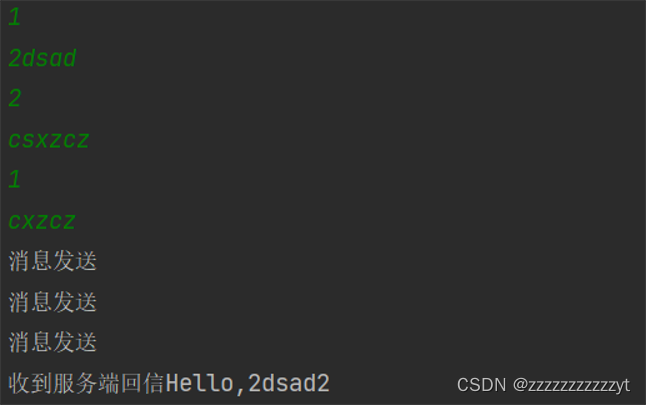更新
v1.1
更新事项
-
解决客户端断开连接后 服务器端也会强制下线的问题
-
原因:当客户端断开连接后 服务端的select会监听到事件 isReadable()不仅会监听到读事件还会监听到玩家下线的事件。
-
解决方案:在读事件捕获异常 优雅的关闭管道 下面是代码实现
try{ //之前的业务逻辑 } catch (IOException e) { //进行关闭 并继续执行 取消键的注册 还有关闭管道 SocketChannel unConnectChannel = (SocketChannel)key.channel(); System.out.println(((unConnectChannel.socket().getRemoteSocketAddress())+"下线了")); key.cancel(); unConnectChannel.close(); } catch (RuntimeException e) { e.printStackTrace(); }
-
-
解决传输时 可能出现的沾包拆包问题

- 原因:TCP是一个“流”协议,是没有界限的一串数据,TCP底层并不了解上层业务数据的具体含义,它会根据TCP缓冲区的实际情况进行包的划分,所以在业务上认为,一个完整的包可能会被TCP拆成多个包进行发送,也有可能把多个小的包封装成一个大的数据包发送,这就是所谓的TCP粘包和拆包问题。
-
解决方案:设置一个标识符 读到标识符时暂停 更换自己的消息发送方式 通过channel 现在改成io
非阻塞的网络io读写只能用到read和write但这个就是只能使用 阻塞的nio了额外开了一个包实现 下面是代码实现 -
尝试使用阻塞io解决粘包问题
//新建请求发送类 package entity; import lombok.AllArgsConstructor; import lombok.Data; import lombok.NoArgsConstructor; //网络传输请求 重点是要实现序列化 否则不能进行io传输 @Data @AllArgsConstructor @NoArgsConstructor public class RpcRequest implements Serializable{ //方法编号 int methodNum; //消息体 String message; }//消费者端 package consumer.nio; import entity.RpcRequest; import java.io.IOException; import java.io.ObjectInputStream; import java.io.ObjectOutputStream; import java.net.InetSocketAddress; import java.nio.channels.SocketChannel; import java.util.Scanner; //阻塞NIO消费端 解决沾包问题 public class NIOBlockingClient { public static void start(String HostName, int PORT) throws IOException { start0(HostName,PORT); } //真正启动在这 private static void start0(String hostName, int port) throws IOException { //得到一个网络通道 SocketChannel socketChannel = SocketChannel.open(); System.out.println("-----------服务消费方启动-------------"); //设置阻塞 socketChannel.configureBlocking(true); //建立链接 阻塞连接 但我们是要等他连接上 socketChannel.connect(new InetSocketAddress(hostName,port)); //真正的业务逻辑 等待键盘上的输入 进行发送信息 Scanner scanner = new Scanner(System.in); //输入输出通道都放在外面 ObjectOutputStream outputStream = new ObjectOutputStream(socketChannel.socket().getOutputStream()); ObjectInputStream objectInputStream = new ObjectInputStream(socketChannel.socket().getInputStream()); //都是阻塞等待 发完了 接收完了 才能进行下一步 不然会报异常 while (true) { int methodNum = scanner.nextInt(); String message = scanner.next(); RpcRequest request = new RpcRequest(methodNum,message); //进行修订 使得可以传送对象 通过自带的io流进行 避免出现沾包拆包现象 outputStream.writeObject(request); System.out.println("消息发送"); try { String msg = (String)objectInputStream.readObject(); System.out.println("收到来自客户端的消息"+msg); } catch (ClassNotFoundException e) { e.printStackTrace(); } } } }//NIO非阻塞服务提供方 主要的代码 package provider.nio; import api.ByeService; import api.HelloService; import entity.RpcRequest; import provider.api.ByeServiceImpl; import provider.api.HelloServiceImpl; import java.io.*; import java.net.InetSocketAddress; import java.nio.channels.Selector; import java.nio.channels.ServerSocketChannel; import java.nio.channels.SocketChannel; //阻塞NIO服务提供端 解决沾包问题 public class NIOBlockingServer { //启动 public static void start(int PORT) throws IOException { start0(PORT); } //TODO 当服务消费方下机时 保持开启状态 /* 真正启动的业务逻辑在这 因为这是简易版 那么先把异常丢出去 */ private static void start0(int port) throws IOException { //创建对应的服务器端通道 ServerSocketChannel serverSocketChannel = ServerSocketChannel.open(); System.out.println("-----------服务提供方启动-------------"); //开启一个选择器 将自己要 Selector selector = Selector.open(); //绑定端口开启 serverSocketChannel.bind(new InetSocketAddress(port)); //设置阻塞 serverSocketChannel.configureBlocking(true); //真正的业务逻辑 就是下面 //循环等待客户端的连接和检查事件的发生 while (true) { SocketChannel channel = serverSocketChannel.accept(); System.out.println("来自"+channel.socket().getRemoteSocketAddress()+"的连接"); new Thread(new Runnable() { @Override public void run() { try { //在内部不断的进行监听 InputStream inputStream = channel.socket().getInputStream(); OutputStream outputStream = channel.socket().getOutputStream(); ObjectInputStream objectInputStream = new ObjectInputStream(inputStream); ObjectOutputStream objectOutputStream = new ObjectOutputStream(outputStream); while (true) { String response; RpcRequest request = (RpcRequest)objectInputStream.readObject(); if (request.getMethodNum()==1) { HelloService helloService = new HelloServiceImpl(); response = helloService.sayHello(request.getMessage()); } else if (request.getMethodNum()==2) { ByeService helloService = new ByeServiceImpl(); response = helloService.sayBye(request.getMessage()); } else { System.out.println("传入错误"); throw new RuntimeException(); } System.out.println("收到客户端"+channel.socket().getRemoteSocketAddress()+"的消息"+response); objectOutputStream.writeObject(response); } } catch (Exception e) { System.out.println("channel"+channel.socket().getRemoteSocketAddress()+"断开连接"); try { channel.close(); } catch (IOException ex) { ex.printStackTrace(); } } } }).start(); } } }





















 2498
2498

 被折叠的 条评论
为什么被折叠?
被折叠的 条评论
为什么被折叠?








